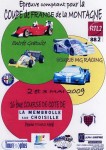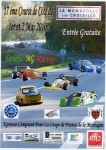| Title: | Course de Côte de La Membrolle sur Choisille |
| Place: | La Membrolle sur Choisille |
| Tracklength: | 2000 metres (until 2017: 1500 metres) |
| Elevation change: | 35 metres (3%) |
| Altitude finishline: | 80 metres |
| GPS coordinates: | 47° 26′ 2.04″ – 0° 38′ 10.6794″ |
| Website: | |
| Fastest Time: | 0:52,87 |
| Average Speed: | 136,18 km/h |
| Short Facts | Blue pinpoint on map shows the 2017 finishline. |
Is there missing or incorrect information on this page? Please let me know in the comments below, or send me an email.
| Date | Winner | Car | Time | Final | |
|---|---|---|---|---|---|
| 02/05/2010 | Michel Baud |  | Martini MK80 | 0:45,24 | Results |
| 01/05/2011 | Julien Bost |  | Dallara F397 | 0:45,05 | Results |
| 29/04/2012 | Julien Bost |  | Dallara F397 | 0:45,06 | Results |
| 05/05/2013 | Serge Thomas |  | Norma M20F | 0:42,17 | Results |
| 04/05/2014 | Julien Bost |  | Dallara F300 | 0:42,99 | Results |
| 03/05/2015 | Christopher Lecarpentier |  | Norma M20 FC | 0:50,71 | Results |
| 01/05/2016 | Serge Thomas |  | Norma M20 FC | 0:42,52 | Results |
| 30/04/2017 | Bernard Jaumier |  | Silver Car S2 | 0:50,111 | Results |
| 06/05/2018 | Anthony Le Beller |  | Norma M20 FC | 0:52,87 | Results |
La Membrolle sur Choisille is a small town just north of Tours. Tours developed into a major city already in the Gallic times. Originally, the city was build between the Loire river in the north and the Cher river in the south. In Medieval times the city was more or less split. In the east there was the area around the Cathedral and the Royal Chateau de Tours. The other part in the west situated around the Abbey of Saint Martin, which is where most economic activity took place. Both parts were fortified, creating a double city. As the city grew the empty space between the two centers was gradually filled with buildings. Many of these late medieval and renaissance buildings still exist and are these days beloved by tourists.
The abbey of Saint Martin is named after one of the most important saints in the Roman Catholic religion. In the fourth century Saint Martin was a Roman soldier, who one day gave half his cloak to a naked beggar. That night he received a vision of Jesus wearing his cloak. Already famous in his lifetime, St. Martin settled near Tours. He founded the Abbey which later carried his own name. St. Martin became one of the most popular saints in the medieval times. In no small part helped by succesive French Kings adopting him as their ‘patron’ Saint. The Abbey and the city profited much from the many pilgrims who visited his shrine and they both gained great wealth. The place where his cloak was worshipped was called the capella (Latin for cloak). The word Chapel is now used to describe every place of worship. During the religious wars in the 16th century the abbey of Saint MArtin was sacked by hugenots and it never fully recovered. It was eventually completely destroyed during the French Revolution. At the end of the 19th Century a St. Martin revival started. On the place near to where the old abbey church once stood, a massive new church in the neo-byzantine style was build to hold his tomb.




